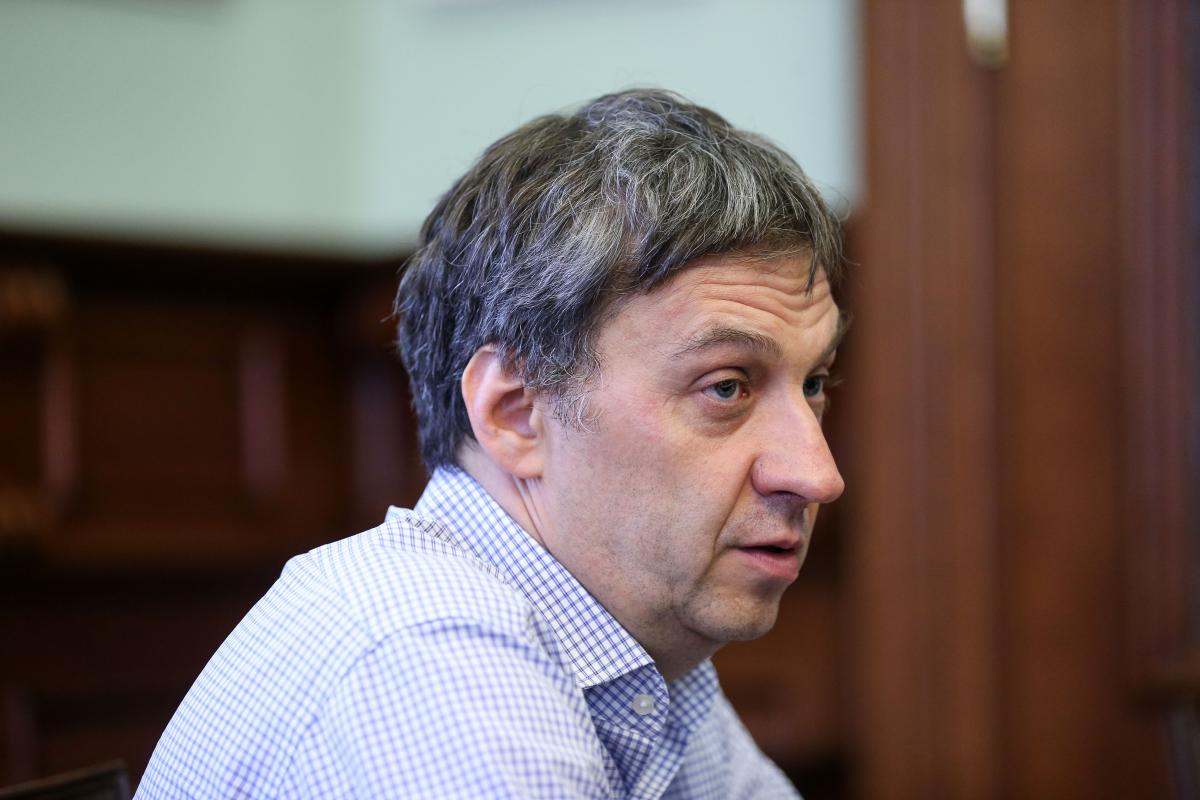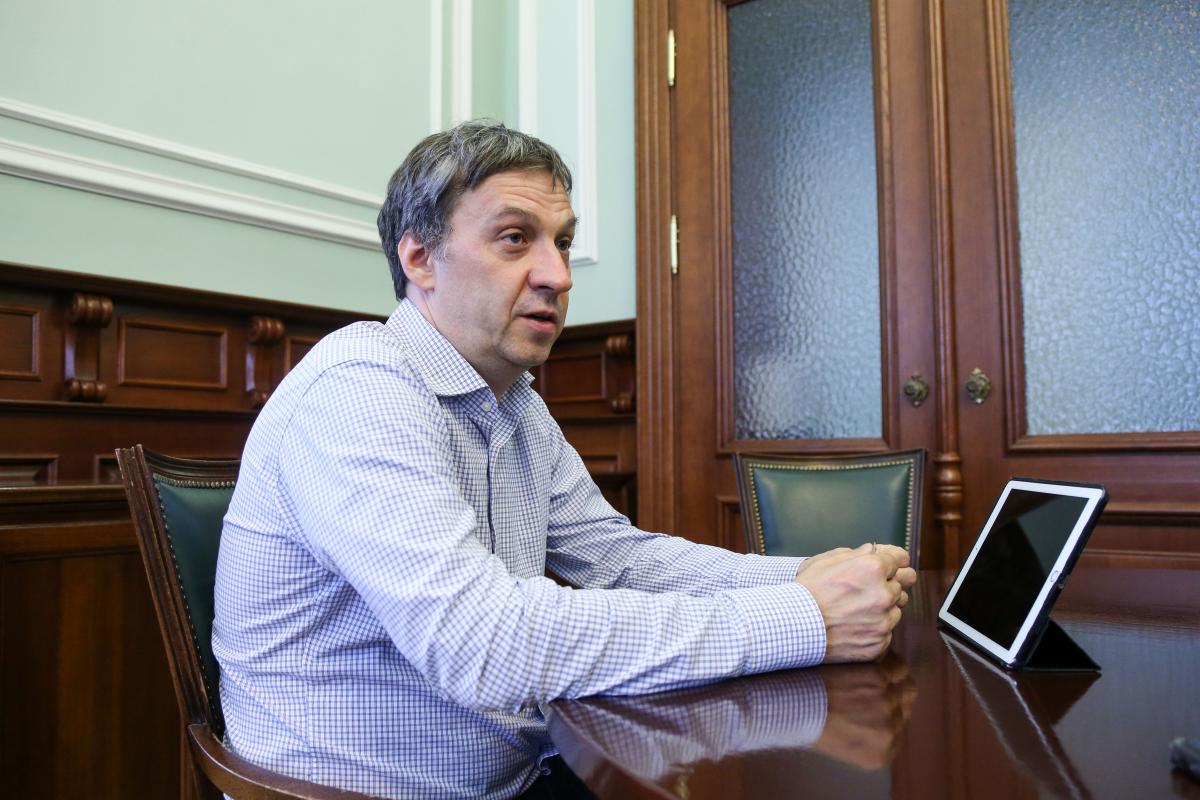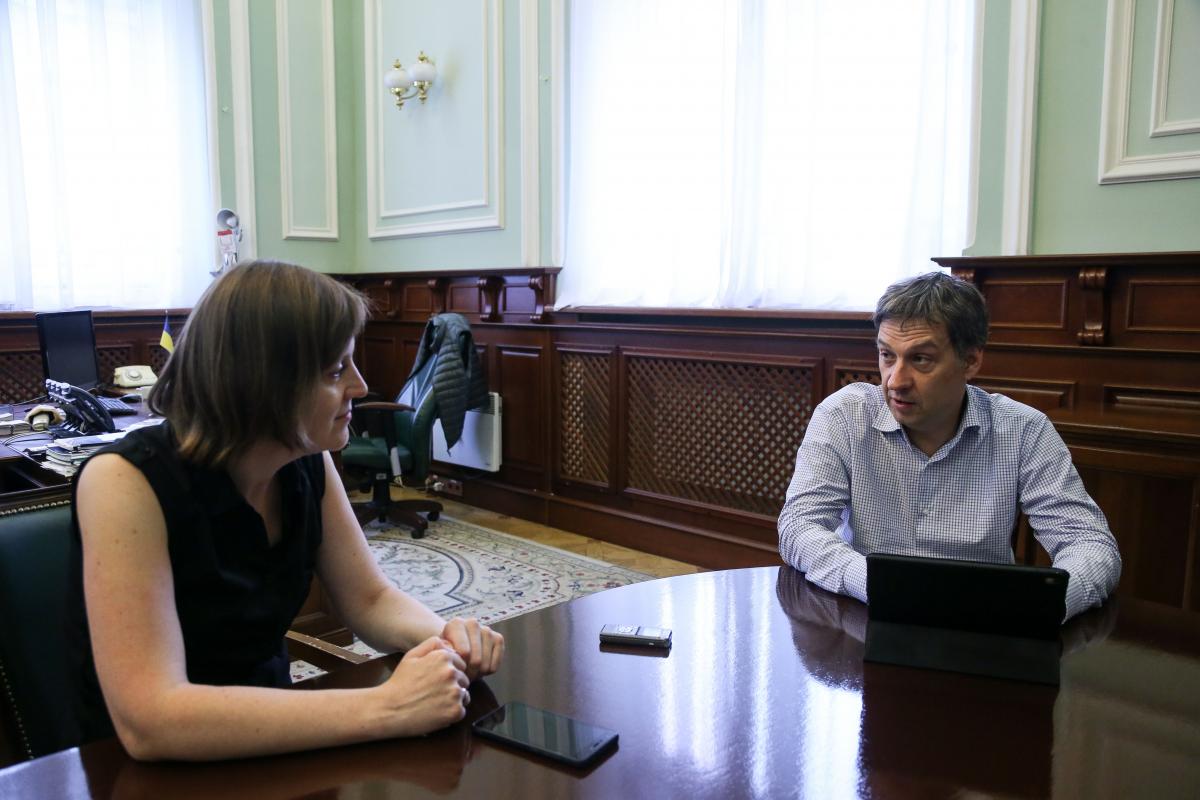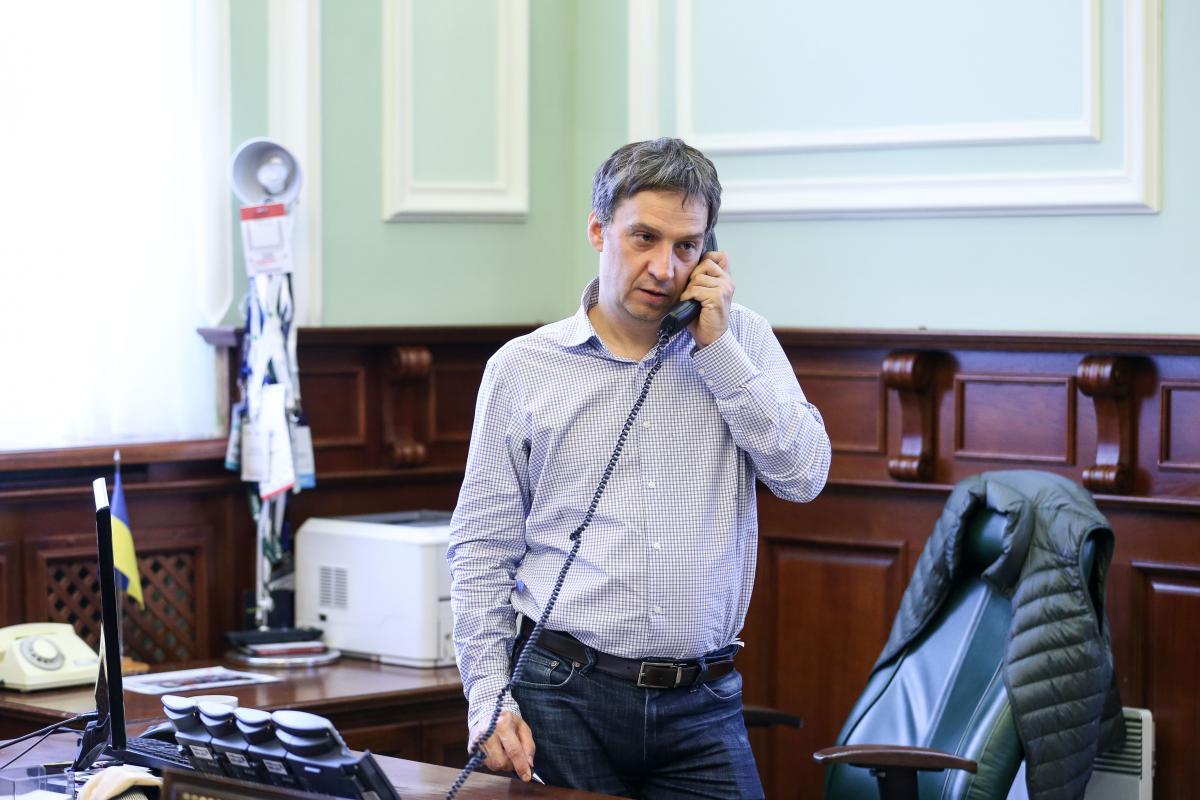
Deputy NBU Governor Oleh Churii: "Our forecast is to receive $2 bln this year under the new IMF program. And next year, too"
The hryvnia for almost two months has been performing at its three-year max, while the effect of one of the key factors – the purchase of government bonds by non-residents – is weakening. Deputy NBU Governor Oleh Churii told UNIAN about the hryvnia's prospects for this autumn, the threat of a recurrence of the 2008 crisis, a new IMF program, debts, and operations of non-residents with government bonds.
The Ukrainian hryvnia is on the rise: after climbing to its three-year highs in July, the national currency has been near UAH 25 per dollar for the second consecutive month.
At the same time, the weakening effect of one of the key positive factors for the foreign exchange market is that non-residents have significantly reduced the purchase of Ukrainian domestic government loan bonds and the corresponding inflows into our country.
Meanwhile, world economists are seeing a serious threat of recurrence of the financial crisis of 2008. At the same time, Ukraine is left with a budget deficit and so far without a new program signed with the International Monetary Fund, facing the need to pay off one of the largest debt payments this year in early September.
Deputy NBU Governor Oleh Churii sat down with UNIAN to tell us of how realistic the threat is of a recurrence of the 2008 crisis in Ukraine, the prospects of launching a new IMF program, the country's readiness to ensure this year's debt payments and repayment of funds to non-residents.
Leading international experts warn of the threat of recession in the world economy. Can Ukraine face the same 2008 crisis experience? What anti-crisis measures are required?
The financial crisis is a real risk for the whole world. With the global economy slowing down, central banks begin to soften their monetary policy. This reduces the cost of money - borrowing rates - and promotes capital inflows to countries offering a higher key rate.
However, compared to 2008, the situation in Ukraine has changed significantly. The economy has become more flexible and stronger. The National Bank has become an actual independent regulator, while the Ministry of Finance adheres to sound fiscal policies. Inflation is on decline. International reserves are now at their six-year high. The balance of payments is also looking good – this year's deficit is expected to be 2.6% of GDP.

The key risk is the negative impact of external trends on the country's balance of payments. The slowdown in the global economy may cause a decline in demand for Ukrainian exports and a reduction in export earnings. On the other hand, this may be offset by a decrease in the prices of goods that Ukraine imports. For example, lowering world energy prices has had a positive impact on our country's trade balance.
In the coming years, Ukraine is expected to make significant payments on foreign debt. And there is a risk that the situation on the capital markets will be unfavorable when it is necessary to borrow money to repay previous debts and cover the budget deficit. At the same time, we hope that Ukraine will be in the program of the International Monetary Fund. This is a signal to investors that our country will carry out reforms. Statements by representatives of the new government indicate commitment to reforms supported by the IMF.
How are things going with the IMF, by the way? Have negotiations already started?
We, together with the Ministry of Finance, are beginning to negotiate with the IMF at the technical level. We're exchanging correspondence. Of course, this is not about signing documents, but the dialogue is underway. We look forward to the arrival of IMF officials in Ukraine once a new government is formed, that is, soon.
If the new IMF program is signed, it will probably include the conditions unfulfilled under the previous program. As for the financial sector, this is adopting the "split" laws (on redistribution of non-banking financial services market overlook functions), protection of financial services consumers' rights, and financial monitoring. Restoring liability for illicit enrichment could also become one of the requirements. As for the increase in domestic gas prices, the IMF's position is not to set a specific price but to reach parity with the market.
Our forecast is to receive $2 billion this year under the new IMF program. And next year, too… But it's not that important whether it will be one, two, or three billion. It doesn't matter much to investors. The main thing is the fact that the program is out there. Together with IMF tranches, we have the opportunity to receive other official funding from international financial institutions.
Do we have enough reserves to pay off our debt this year without IMF tranches?
I'd say that the situation looks quite comfortable, as earlier this month the Ministry of Finance fulfilled its annual borrowing target by about 90% and is now able to focus on cutting the borrowing rate. Of course, that's provided that the situation in the world economy is fairly stable.

The funding demand by the end of the year, if we meet the budget deficit targets, is relatively small – about UAH 100 billion. Even if we continue to raise funds through domestic government bonds without using other sources, it is quite realistic, at UAH 20-25 billion a month, or about UAH 4-5 billion per auction. These are relatively small amounts.
Today, the process of replacing the foreign currency debt with the one inhryvnia is underway, so the Ministry of Finance will probably continue to raise funds through the sale of government bonds.
That is, there is no need any more to enter foreign capital markets this year, right? At what rate could we now borrow?
This issue is primarily within the competence of the Ministry of Finance. For my part, I would say that the global interest rates on risk-free assets are falling significantly. But risk bonuses are very volatile. Investors are behaving very carefully now, as there is anticipation of a global recession.
Will reducing government bonds rates deter non-resident investors?
The rates are essentially determined by non-residents themselves as they submit their bids for auctions with fixed volumes. And while previously, government bonds rates were tightly tied to our discount rate, now this link is no longer so obvious. The arrival of foreign investors has changed the rules of the game. Since year-start, the short-term bond rate has dropped by about three percentage points, while the NBU key rate has fallen by only one. This is a question of supply and demand. If there is a large demand and a fixed supply, there is potential for a lower rate.
The potential for non-residents entering government bonds is still quite significant. The non-resident portfolio is only 11-12% of the total hryvnia government bonds in circulation, or about 20% without the NBU portfolio. For example, in Peru it's 55%, the Czech Republic has 40%. In Indonesia, South Africa, Mexico, it's about 30-40%.
Why have non-residents so rapidly increased the share in government bonds market as opposed to local investors? And if they are going to reduce their share just as rapidly, are we ready for the currency outflow?
First, central banks in developed countries are now softening their monetary policies, thus increasing interest in alternative investments. Secondly, launching a link with Clearstream International Depository has significantly simplified non-residents' access to our market. Third, they are attracted by relatively high yields in Ukraine.

Professional investors evaluate their risks fairly well, working in the markets of many developing countries, and see their opportunities. A foreign fund that invests in Ukrainian government bonds may have about $4-5 trillion in assets. For such a fund, the volume of investments in Ukraine is a penny.
At the same time, when it comes to the risks of "hot" capital, the exit of non-residents from government bonds can't be too rapid, as it is mainly about long-term investments. Of course, bonds could be sold in the secondary market, but the liquidity of this market is limited. So investors will keep that in mind.
As inflation declines, borrowing rates also do. But this does not mean that non-residents will immediately withdraw all their funds. Foreign investors also buy bonds at lower rates. The share of non-residents in the debt market in Eastern Europe is quite high. This can be, for example, 20-40% against a few percent yield.
How much do we now depend on this currency flow? Could a sharp decline in the inflow from non-residents bring down the hryvnia?
Over the past few weeks, currency inflows from non-residents have been very small, with some even coming out of government bonds. But this had no significant impact on the exchange rate. Now Ukraine has acceptable trading conditions: favorable prices on the world market and high yields.
Risks are always out there. The question is how significant they are. It's not only foreign investors who form foreign currency inflow into the countr. Since the beginning of the year, they have brought in about $3 billion. This is less than 10% of our exports. Even with regard to the national debt, their investment is not large - about 4%.
The main risk for Ukraine is not high debt. The state debt to GDP ratio in Ukraine is about 55%. It's even lower than in Egypt [over 90%], whose rating is higher. The problem is that about 70% of Ukraine's public debt is in foreign currency. This figure should be reduced – to replace the foreign currency debt with that in the hryvnia.
Investors receive relatively high yields on domestic government bonds, but they also bear the foreign currency risk. In our view, the arrival of non-residents and the development of the domestic debt market will help reduce currency risks. And, together with the Ministry of Finance, we support this trend.

Experts believe that in the current situation, the National Bank should buy more foreign currency to replenish reserves. Why are you buying so little?
Since the beginning of the year, we have bought almost $3 billion more than we sold. As for our foreign exchange market policy, the National Bank has two types of interventions. The first one is solely to build up reserves without affecting the rate. These are small-scale interventions – up to $20 million per day, which we spend if the hryvnia is stable or strengthened.
The second type of intervention is aimed at smoothing the sharp currency fluctuations in one direction or another. Although I can't tell you what kind of fluctuations we consider sharp. If the market is aware of these options, it will play against the National Bank. I can only say that when we switched to a floating rate policy in 2015, the fluctuation parameters were much narrower. In order for the marker to get used to this gradually and without panic, during this period our interventions were quite frequent. Now the range of fluctuations is much wider, but it is in line with the practice of other developing countries. Gradually the population is getting used to the fact that the rate is floating and that the hryvnia can both weaken and grow. For example, a change in the rate by some one percent within 24 hours has no effect on businesses or citizens.
Turning to the question of why we buy little currency, I can say that we buy up almost all the excess. We bought almost 100% of the money that came from non-residents. Had we bought more, we could have hindered the strengthening of the hryvnia. But our goal is not to influence exchange rate formation but to replenish reserves and prevent sharp fluctuations.
Is there a currency inflow into the country this year if we consider real money rather than virtual money? That's without technical recapitalization of banks and other such transactions...
Of course, there is such inflow. The NBU buys up the excess of money. This is a net inflow, $3 billion, which we bought in less than a year. For the whole last year, we have bought 50% less, only $1.4 billion.

This year, the National Bank lifted a number of restrictions on the foreign exchange market, including on the maximum amount of dividends paid to foreign investors and the mandatory sale of foreign currency. Did these steps not have a negative impact on the market?
Forex liberalization caused no significant outflow of currency. The abolition of restrictions increases volatility to some extent, but it carries no risks for the economy, and Ukrainians are already getting used to moderate fluctuations.
Can you say that everything will be fine this fall? In early September, we're facing one of the largest debt repayments this year, which is $1 billion. Could this affect the exchange rate?
The Ministry of Finance is a client of the National Bank. The Ministry of Finance conducts all operations exclusively with the National Bank without entering the market. If there is a need for payments in foreign currency and there is free hryvnia liquidity, the currency is purchased at the NBU rate, and this has no effect on the market. To date, the Ministry of Finance has accumulated sufficient funds in both national and foreign currencies. And there is no doubt that the Ministry of Finance is ready to make all the necessary payments.
So what will happen with the rate? Will it stay within the forecast range? Will the National Bank adjust the budget forecast for next year at the request of the Ministry of Finance?
The forecast is not the goal. When we were drafting the forecast, no one expected such an inflow of currency from non-residents and such favorable trading conditions. The Ministry of Finance and I are actively working to look at options for reducing the impact of the rate on budget indicators. But this does not mean that the National Bank will change its policy. In particular, we are not even considering a return to the fixed rate policy, as such policy has led to two very serious crises.
On the one hand, hryvnia strengthening provokes short-term non-receipt of scheduled budget revenues from imports. On the other hand, the costs of debt repayments are reduced, since in this case the Ministry of Finance is able to buy foreign currency at a more favorable rate. In the long run, a strong rate will have a positive effect on debt sustainability, reducing the debt-to-GDP ratio. It will also contribute to positive investor sentiment and lower borrowing rates.

Which rate can be considered optimal for Ukrainian businesses and citizens? Some experts talk of the threats of sharp appreciation of the hryvnia.
Hryvnia fluctuations cannot be called too sharp when compared to other countries' currencies. The optimal rate is a market rate that is shaped by supply and demand, stabilizing the balance of payments. It is clear that the exporters do not like the sharp appreciation of the currency, while the importers don't like devaluation. But the market rate balances everything in the interests of the economy.
Who dictates the weather in the forex market today? What factors should we pay attention to?
Key factors have not changed: it's exports, imports, attraction and return of financing. But there are other factors. If the country implements the reforms required, it will help to attract not only portfolio but also direct investment. In recent years, a very low level of direct investment has been a negative factor for the Ukrainian economy. We hope that the business climate will improve and this will help attract investors.
Can the risk of Russian gas transit halt via Ukraine and the loss of corresponding foreign exchange earnings be realized? What do the NBU forecasts say?
Our forecasts are rather conservative – we expect a drop in transit revenue by more than 66% next year. Accordingly, this will affect the balance of payments. But this does not automatically mean losing a certain amount of currency. The situation is dynamic; various factors can compensate for each other.

Does the next year's forecast include repaying a $3 billion "Yanukovych loan"?
It doesn't. If this is a force majeure, we will be amending our forecast. Risks are always out there.
What about the key rate and bank credit rates?
We have published our Key Rate Forecast. According to this forecast, the rate is expected to drop to 8-9% in the next few years. How will this affect credit rates? Our rate is only one component of the credit price. Another component is credit risk. If banks feel that credit risk is diminishing, if the protection of creditors' rights is strengthened, and judicial reform is carried out, this margin will also decrease.
The new government is coming to power. Do you see any prerequisites for changes in the NBU board?
We have commented many times on this issue. I can't add anything new. Nothing has changed yet.
Olha Hordienko

